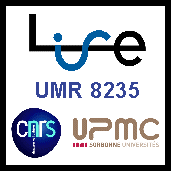The corrosion induced by alternative current on buried steel pipelines under cathodic protection.
La corrosion induite par courant alternatif sur les canalisations enterrées sous protection cathodique.
Résumé
Pipelines buried in soil are protected by a thick organic coating complemented by cathodic
protection. This double precautions permit to preserve the durability of gas or petrol
transmission networks. In spite of this double protection, when these pipelines are in the
vicinity of a high voltage AC electrical field, such as a power line or an electrical railway for
instance, corrosion may occur at the location of coating holidays, named “AC corrosion”.
Practically, AC corrosion phenomenon is widely observed and, still, there are little
fundamentals’ studies about it.
AC corrosion origin and the effects of some parameters such as: AC amplitude, CP
polarization, soil electrolyte’s conductivity, and bulk pH, have been examined, theoretically
and experimentally, by using a carbon steel disc electrode in simulated natural soil water. This
phenomenon may be explained by two approaches:
The first one takes into account the direct current (faradic rectification) created due to the
non-linearity of interface response under AC perturbation. As a consequence, this DC current
may make the cathodic protection (polarization) less efficient.
The second approach is based on the study of the relationship between the anodic faradic
current and the AC phenomenon. Towards this aim, a special device has been developed
which allows recording both the instant current and potential signals, synchronously, and
then, through signal treatments, permits to split the total measured interfacial current value
into the faradic component (the part of the total interfacial current circulating through the
faradic branches of the circuit) and the capacitive component (the part circulating through the
capacitance). The method was used to calculate the anodic faradic current. The existence of a
phase shift between faradic and capacitive current has been highlighted. Though it may have a
significant effect on the magnitude of the faradic current, the effect of the electrolyte
resistance has been found to be even more important, under the experimental conditions
tested. The analyses of corrosion products accumulated at metal surface showed that the AC
signal at 50 Hz may be too fast for electrochemical kinetics reasons to quantitatively
transform sufficient amount of corrosion products at each cycle so that the effect could be
detected through the experimental tools and methods adopted.
Les conduites de gaz enterrées en acier sont toujours protégées contre la corrosion par un
épais revêtement organique complété par une polarisation cathodique. Cette double précaution
permet de préserver l’intégralité du réseau de transport de gaz ou de pétrole dans la majorité
des cas. Cependant, lorsque ces installations se trouvent près de courant alternatif de forte
intensité, le champ électromagnétique créé induit une corrosion externe de pipeline au niveau
des défauts discrets du revêtement, appelée « corrosion AC ». Si ce phénomène est largement
observé en pratique, peu d’études fondamentales ont été réalisées.
L’origine de la corrosion AC est recherchée à la fois par des analyses théoriques et par des
observations expérimentales sur une électrode d’acier immergée dans une solution simulant
les eaux souterraines. La première approche consiste à tenir compte de la non-linéarité de la
réponse électrochimique sous une perturbation de potentiel de forte amplitude, laquelle
conduit à un processus de redressement faradique. Le champ alternatif a pour effet
d’augmenter le module du courant continu. Aussi bien pour le courant anodique que pour le
courant cathodique. Le résultat est une protection cathodique moins efficace voire
insuffisante.
La deuxième approche est de déterminer le courant faradique anodique, c'est-à-dire la valeur
efficace du courant faradique positif sous perturbation AC. Cependant, le courant observé
expérimentalement est la somme du courant de charge de capacité de double couche et de
celui d’origine faradique. Un dispositif et une procédure de traitement de données originaux
ont donc été développés dans ce travail pour évaluer le courant anodique faradique. Nous
avons noté un déphasage entre le courant de charge et le courant faradique qui est un
paramètre important, au même titre que l’amplitude de signal AC. La résistance d’électrolyte
a été également identifiée comme un paramètre important.
L’analyse de produits de corrosion accumulés à la surface de l’électrode a démontré que le
signal de 50 Hz est trop rapide pour engendrer une réaction d’oxydo-réduction décelable avec
les moyens d’analyse et dans les conditions d’essais adoptés.
Loading...

